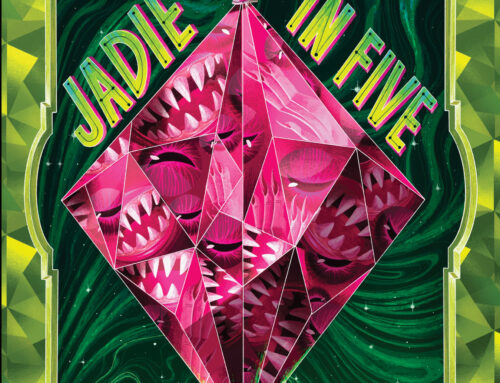Jordan Stratford’s new middle grade series, The Wollstonecraft Detective Agency features some very clever and clandestine girls. Best of all, the characters are based on two brilliant girls in history , Ada Lovelace (the world’s first computer programmer) and Mary Shelley (author of Frankenstein). The story is set in authentic 1826 London. Jordan’s passions for history, science, math, and literature come together perfectly in these books! I asked Jordan how he came up with such an inventive idea.
, Ada Lovelace (the world’s first computer programmer) and Mary Shelley (author of Frankenstein). The story is set in authentic 1826 London. Jordan’s passions for history, science, math, and literature come together perfectly in these books! I asked Jordan how he came up with such an inventive idea.
Middle Grade Mafia: The Wollstonecraft Detective Agency has both STEM connections and meets the Common Core curriculum. Can you tell us how you were able to get these sort of “designations” and did you have them in mind before you wrote the book?
Jordan Stratford: Well, CC is just content, and I’m aware that there are core concepts that Middle School readers are exploring, so when I’m world-building it helps to give them something to hang all that on. It’s natural connection-making that kids do all the time. So it’s not about any great conspiracy, it’s just respecting the landscape of the reader. The fact that this makes life easier for teachers is gravy.
I certainly haven’t shied away from pushing the vocabulary, which is quite outside typical MG, but I have a great deal of confidence in readers and their ability to either use context or just ask or look stuff up. They’re all brilliant, these kids. I just acknowledge that and let them play with the story.
But as to the STEM thing, yes, it was always an important agenda-item for me that girls particularly encounter real-world historic role-models in science. Ada’s such a fascinating character and the connection to Mary, via Ada’s father and Mary’s future husband as best friends, and business regarding sisters that requires some kind of diagram, was too good to pass up.
MGM: The two main characters Ada and Mary (who are rather clever and clandestine) are based on real people in the early 1800’s. How did you come up with the idea for this book?
JS: I just always loved Mary’s middle name: Wollstonecraft. It takes your whole mouth to say it. A great chewy word. And it was the name of Mary’s mother, the feminist writer, who was a great chewy person. Like her name, she takes some effort. It’s very Gothic and labyrinthine. So it was the word that kicked it off.
But here we have, in real life, these two girls who changed the world AS young girls. They didn’t wait to grow up or ask permission. Ada invented computer programming and was the first to envision computers as something other than just calculators, but instruments for art and music. And Mary invents an entire literary genre, and the trope of the mad scientist – she does all of this at the age of sixteen. So I got a hammer and banged their chronologies together (ChronoBanging!™), so that Mary and Peebs’ years would line up with Ada and Charles’, which results in some very interesting things about sisters. But we’ll get to that.
Point is, here are two complementary ways of looking at the world; the analytical and the imaginative, and they’re not contradictory. They work together. Intuition and data. Wondering and testing. It’s the most human thing ever, this relationship. That’s a great start to a story.
MGM: The story submerges the reader into 1826 London, how did go about researching the time period?
JS: I read Jane Austen until my head fell off, and then I looked at “Regency” tumblrs ’til my eyeballs rolled out of my head. I also spent a lot of time Google-street-viewing around London, and looking up historic buildings, neighbourhoods I had walked around at nineteen. So it gives you a sense of shape, of distance and time and proximity, onto which to graft all the lovely aesthetic stuff.
MGM: Your website has so many great resources for readers as well as teachers. How did you develop the content for www.wollstonecraftdetectiveagency.com?
JS: When I first signed with Knopf (Penguin Random House) I said that these kinds of resources were part of the deal, that we had to empower librarians and educators with tools to connect the story to whatever else kids were exploring at the time. This is a value that excites my editor as well, and so she helped champion that in-house. It’s an easy conversation, really – people get it. Yes, of course, if we’re going to showcase these characters and use history and engineering and mathematical concepts and literary in-jokes, of course we’re going to be part of that classroom conversation.
MGM: You mention in your acknowledgments that you did a Kickstarter campaign, can you tell us a little bit about this?
JS: When I first conceived of this, I knew there was something to it but I wanted to test it. I invited Kickstarter as a community to become involved, and it was my amazing cohort of backers who really convinced me to keep going with it, to take from a book to a series with all kinds of branches spreading out, including short stories and learning tools. My backers got an early read of the book, gave me advice, asked hard questions, cheered me on, called me on my mistakes, as well ask kept me going for two years. That’s so valuable, a community that’s invested in the success of what you’re doing because the values matter to them. It’s a little terrifying, to be honest, and it would be actually awful if they weren’t the best people. Seriously, the most warm-hearted, generous, amazing people who want to make the world a better place through science and imagination and girl-power. I love them.
MGM: The book has No 1 clearly on the front cover, which implies there will be more books. What else is in store for The Wollstonecraft Detective Agency?
JS: Book Two is in production now, I finished writing it in 2013 and it will be out in eight months from now. Book Three is in copy-editing which means arguing about British vs. American spellings and semi-colons. I’m writing Book Four. But I’ve also written a feature screenplay, treatments for educational games, various versions of the short story I’ll release with Book Two (it will be free on the website), and other licensing opportunities. But every January means a new Wollstonecraft book on the shelves.
In terms of the story, well, I’ve always subscribed to the idea of storytelling as defining what your characters want and not giving it to them. Generally making them suffer for 200 pages, and then handing them a cookie for putting up with you as an author. So of course the first thing you have to do at the start of the second book is take that cookie away. “Things aren’t working, can they make it work? It’s almost working! It’ll never work! No, wait, they can make it work! The end!” and therefore to keep everyone interested you have to remove that particular solution as the story goes on. They have to find another way.
But no experiment is a failure if it yields data, and there’s always another way to try. I think that’s one of the key takeaways of the world of Wollstonecraft.






Fantastic interview! Can’t wait to read his books.